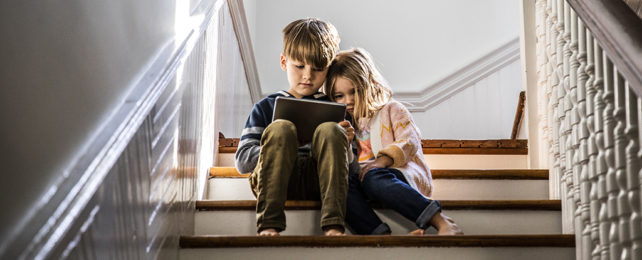Putting a screen in front of a child is a tried and trusted way of keeping them entertained and quiet – and it works pretty well for adults, too – but as a constant calming technique, it may have its drawbacks, according to a new study.
Researchers looked at the way digital devices were used to soothe upset children aged between 3 and 5 years old. The study involved 422 parents and the same number of children and was carried out between August 2018 and January 2020, before the COVID-19 pandemic upended schools and home life.
What the team found was that increased use of devices as calming mechanisms was linked to greater emotional reactivity or dysregulation in the kids over the course of several months: think rapid shifts between moods and heightened impulsivity, for example.
The association was particularly strong in young boys and in children who already had signs of hyperactivity, impulsiveness, and a strong temperament. It seems as though these gadgets can prevent kids from developing their own ways of regulating emotions.
"Using mobile devices to settle down a young child may seem like a harmless, temporary tool to reduce stress in the household, but there may be long-term consequences if it's a regular go-to soothing strategy," says developmental behavioral pediatrician Jenny Radesky from the University of Michigan.
"Particularly in early childhood, devices may displace opportunities for development of independent and alternative methods to self-regulate."
Of course, as any parent or carer would know, the age group looked at in the study includes kids that are particularly prone to tantrums, intense emotions, and fighting back against the world, which makes the option of using a tablet or a phone to calm them down all the more appealing.
And it works too – but what the researchers are suggesting is that short-term relief from an upset child might be leading to long-term problems with their emotional development. Other ways of coping can get shut out.
The study's authors are keen to emphasize that device use in moderation can be useful and can't easily be eliminated altogether while also warning that it shouldn't be used as a primary or frequent way of trying to keep children calm.
This is a topic that isn't new, and in the past, parents have been concerned about giving their youngsters too much television time or playing video games. The modern-day media-consuming experience is much more fragmented, interactive, and accessible, however.
"Caregivers may experience immediate relief from using devices if they quickly and effectively reduce children's negative and challenging behaviors," says Radesky. "This feels rewarding to both parents and children and can motivate them both to maintain this cycle."
"The habit of using devices to manage difficult behavior strengthens over time as children's media demands strengthen as well. The more often devices are used, the less practice children – and their parents – get to use other coping strategies."
The researchers have put forward some other options for calming kids down, including sensory experiences (from listening to music to squishing putty in their hands to jumping on a trampoline), and the deliberate naming of emotions to help understand them.
Color-coding emotions can also help kids learn, identify and understand their moods, and easily communicate how they are feeling. Offering replacement behaviors, including hitting a pillow, rather than hitting a sibling or a friend, can also help.
These options can be talked through and explained while kids are calm, the researchers suggest, before any tantrums strike. Meanwhile, screen timers and strict boundaries around the use of apps might also be ways of keeping control over device use.
"All of these solutions help children understand themselves better and feel more competent at managing their feelings," says Radesky.
"It takes repetition by a caregiver who also needs to try to stay calm and not overreact to the child's emotions, but it helps build emotion regulation skills that last a lifetime."
The research has been published in JAMA Pediatrics.
